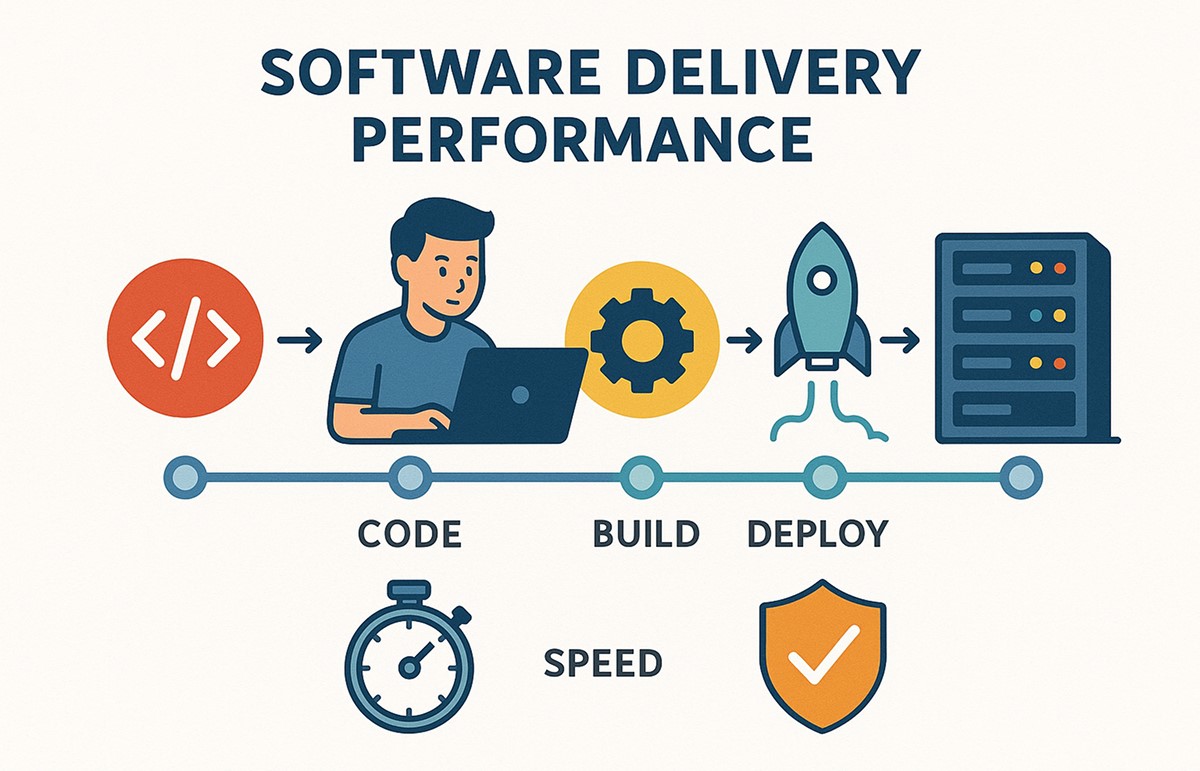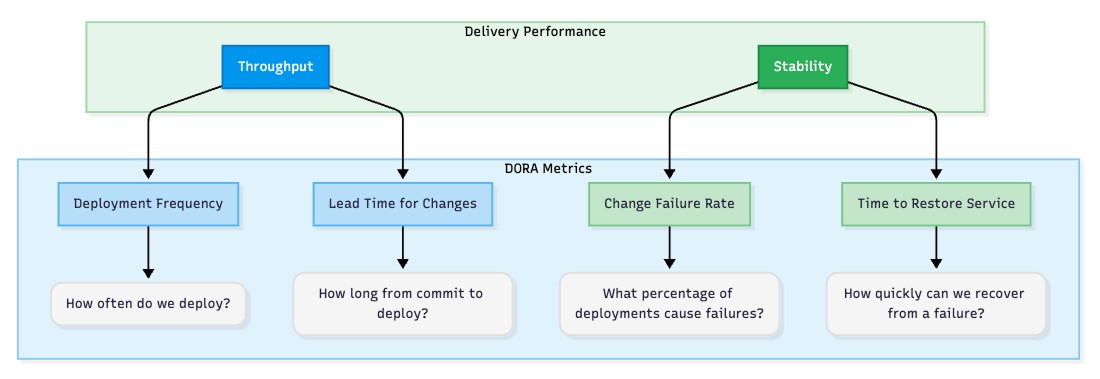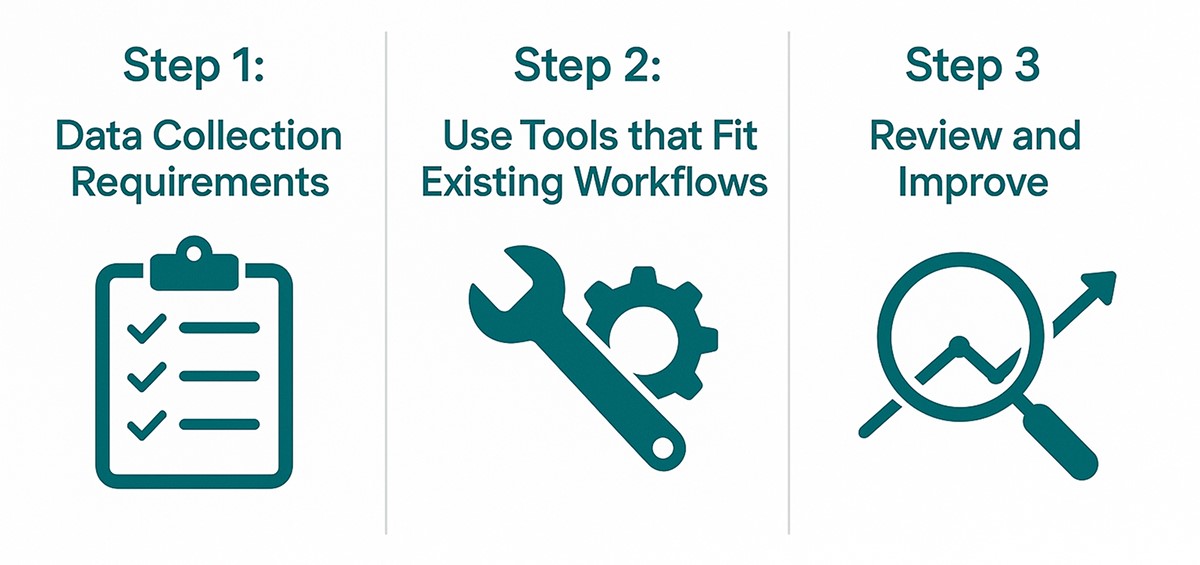A large part of any app’s value comes from getting it into users’ hands quickly and reliably. Studies show that top-performing teams ship code to production about 180 times faster than low performers. That speed translates into happier customers and steady revenue.
However, only one in four engineering teams has actually started using AI in its delivery pipelines. Most groups are still slowed by manual reviews, long test suites, and fragile deployment scripts. Improving software delivery performance removes those roadblocks. Faster releases give you quick user feedback, more room for innovation, and reduce developer burnout.
This article breaks down the steps to streamline your pipeline so you can deliver features sooner, with less stress, and stay ahead of the competition.
What Is Software Delivery Performance?
Software delivery performance refers to how fast, reliably, and efficiently an organization can provide software updates to users. It covers the entire process, from code commit to production deployment, and measures both speed and quality throughout.

The main features are:
- Speed: How quickly code moves from development to production
- Quality: How reliable and bug-free the delivered software is
- Efficiency: How well resources are utilized throughout the process
- Consistency: How predictably the team can deliver changes
Simply put, strong software delivery performance shows that your team can ship features quickly, keep them stable, and use people and infrastructure wisely.
Why Measuring Software Delivery Performance Matters
Tracking the performance of software delivery gives businesses important information that helps them succeed. There are many reasons why measurement is so important:
Eliminates guesswork
- Uses hard numbers (lead time, change failure rate) instead of assumptions
- Supports objective decisions that match business goals
Identifies specific pain points
- Pinpoints where delays occur (e.g., code review taking a majority of delivery time)
- Shows which stages consume the most resources and time
- Helps prioritize improvement efforts for maximum impact
- Prevents teams from optimizing low-priority areas first
Aligns technical and business goals
- Connects technical metrics to revenue, customer satisfaction, and growth
- Builds a stronger relationship between technology and business stakeholders
- Enhances strategic decision-making and the distribution of resources
Supports a culture of continuous improvement
- Establishes accountability by providing clear performance visibility
- Teams can track progress over time and celebrate wins
- Creates a baseline for evaluating initiatives for improvement
Effective teams can roll out changes several times a day with minimal problems. However, low-performing teams may take weeks to implement changes, which can still result in production issues. Speed is crucial when delivering software, but you also need to maintain quality, security, and reliability.
Key Software Delivery Performance Metrics
Metrics help to switch subjective perceptions of team productivity into objective, actionable data. The four DORA software delivery performance metrics are a great place to start, as they serve as the industry baseline for measuring software delivery performance.
The Four DORA Metrics
After many years of research and experience, Google Cloud’s DevOps Research and Assessment (DORA) team has identified four key metrics that effectively measure software delivery performance:

1. Deployment Frequency
- Defined as how often a team successfully deploys code to production.
- Why it matters: It indicates the team’s ability to consistently deliver value to users.
- High-performing teams deploy multiple times per day or on demand.
- Low-performing teams deploy every six months or once per month.
- Business impact: More frequent deployments reduce batch size, lower risk, and enable faster user feedback.
2. Lead Time for Changes
- The duration between a successful code commit and production deployment.
- Why it matters: It evaluates the overall delivery pipeline’s efficiency.
- High-performing teams require less than a day.
- Low-performing teams take weeks or months.
- Business impact: Quicker reactions to customer demands and market shifts.
3. Change Failure Rate (CFR)
- The percentage of deployments that cause production failures requiring immediate remediation.
- Why it matters: It balances speed with quality and system reliability.
- High-performing teams: ≈ 5 %
- Low-performing teams: ≈ 40 %
- Business impact: Lower operating costs while preserving client confidence.
4. Time to Restore Service
- The total time taken to recover from production failures.
- Why it matters: Reflects incident response capabilities and system resilience
- High-performing teams restore service in less than one hour.
- Low-performing teams can require one week to one month.
- Business impact: Minimal revenue loss and customer impact
Tip: Measure these four together. High-performing teams demonstrate both speed and stability simultaneously.
Additional Software Delivery Performance Metrics
While DORA metrics provide excellent baseline measurements, teams can benefit from tracking additional on-time delivery metrics.
- Technical Debt Index: A measure of code quality and maintainability issues
- Customer Satisfaction (CSAT): User satisfaction with software releases
- Code Review Time: The time from opening a PR to approval
- Test Coverage: How much of the functional code is covered by automated tests
How to Measure Software Delivery Performance

To measure software delivery performance, you must regularly collect data on key metrics and use appropriate tools to analyze trends. The first step is to collect the necessary data points for the measurement process.
Step 1: Data Collection Requirements
- Track the same events – such as commits, build results, deployments, and incidents – everywhere.
- Metrics lose value if they are sampled only at release time. So, collect them continuously.
- Pull data straight from your CI/CD system, VCS, and incident tracker without human intervention.
Step 2: Use Tools that Fit Existing Workflows
CI/CD Tools
- Tools: GitHub Actions, GitLab CI/CD, Jenkins, CircleCI
- Capabilities: Real-time deployment frequency tracking, pipeline success rates, build duration monitoring, built-in analytics, automatic bottleneck identification
- Best practices: Configure alerts for failed pipelines, track deployment success rates, monitor build times
Project Management
- Tools: Jira, Linear, ClickUp, GitHub Issues
- Capabilities: Lead time measurement, work breakdown analysis, cycle time tracking, work item lifecycle visibility, team capacity insights, progress tracking
- Best practices: Standardize work item states, track time in each stage, automate status updates
Specialized DORA Metrics Platforms
- Tools: Sleuth, Harness Developer Hub, Waydev
- Capabilities: Four-metric dashboard, cross-tool data aggregation, trend analysis, unified view of all DORA metrics, automated data collection, benchmark comparisons
- Best practices: Connect multiple data sources, set up regular reporting, set performance targets
Delivery Analytics Platforms
- Tools: Opsera, Velocity, LinearB, Code Climate
- Capabilities: Advanced analytics, predictive insights, team performance benchmarking, pattern recognition, improvement recommendations, performance benchmarking
- Best practices: Regular performance reviews, action item tracking, continuous optimization
Step 3. Review and Improve
- Share dashboards with engineering and product leads so everyone sees the same numbers.
- Pick the worst metric first (e.g., longest lead time) and run a focused improvement experiment.
- Re-measure after each change to confirm progress and avoid local optimizations that hurt the big picture.
Common Challenges That Hurt Delivery Performance
Software delivery performance is primarily impacted by several persistent issues in all organizations. First, let’s try to understand these obstacles so we can develop targeted improvement strategies.
1. Overly complex code review processes
Multiple mandatory reviewers, long merge queues, and unclear approval rules leave code waiting for sign-off instead of delivering. This significantly increases the lead time and throttles deployment frequency.
2. Insufficient test automation coverage
Relying on manual testing processes results in limited, slow, and unreliable test execution. This forces teams to choose between deployment speed and quality assurance, increasing the change failure rate.
3. Monolithic architecture and technical debt
Large, tightly coupled codebases with outdated libraries require extensive test cycles and coordinated rollouts. This can significantly reduce deployment frequency and increase risk.
4. Poor incident response and recovery processes
Teams struggle to discover, diagnose, and resolve production issues quickly due to a lack of automatic recovery mechanisms, insufficient alerting systems, and unclear escalation paths. This causes longer outages and greater customer impact.
5. Limited monitoring and observability
Poor visibility into system performance and a reliance on reactive monitoring. Teams will be unable to detect what went wrong and when, resulting in poor response times.
Improving Software Delivery Performance
Here are six straightforward steps that top teams use to speed up and steady their releases:
1. Automate your CI/CD pipeline
- Configure every commit to start an automatic build, test, and deploy to a test environment.
- Reuse the same script for staging and production so each environment is built the same way.
- Automation eliminates manual errors and keeps releases predictable.
2. Strengthen test automation
- Add unit, integration, and end‑to‑end tests that run inside the pipeline.
- Good tests catch bugs in minutes, so you can ship with confidence.
- AI tools can help write test cases faster. But focus on test reliability first.
3. Move to trunk‑based development
- Merge small changes into the main branch several times a day instead of keeping long‑lived feature branches.
- Short pull requests review quickly, avoid big merge conflicts, and keep lead time low.
4. Use feature flags and gradual rollouts
- Wrap new code in flags so you can turn a feature on for a small group before a full launch.
- Pair flags with canary or blue‑green deployments.
5. Set up solid monitoring and alerting
- Track business metrics, app performance, and infrastructure health in real time.
- Clear dashboards and alerts help spot problems early and reduce recovery time.
6. Build a continuous‑learning culture
- Review metrics often, run blameless post‑mortems, and try small experiments to fix the slowest parts of the pipeline.
- This constant feedback loop keeps performance moving in the right direction.
Conclusion
Maximizing software delivery performance is not a one-time thing. It is an ongoing effort. You must set clear goals, track the right metrics, and deliver improvements step by step. For example, you can start by tracking the four DORA metrics. These metrics show how quickly and safely your code reaches users and point out the slow or risky areas. Then, start fixing one area at a time and keep repeating the cycle. Soon, you will realize that your team is releasing faster with confidence.


